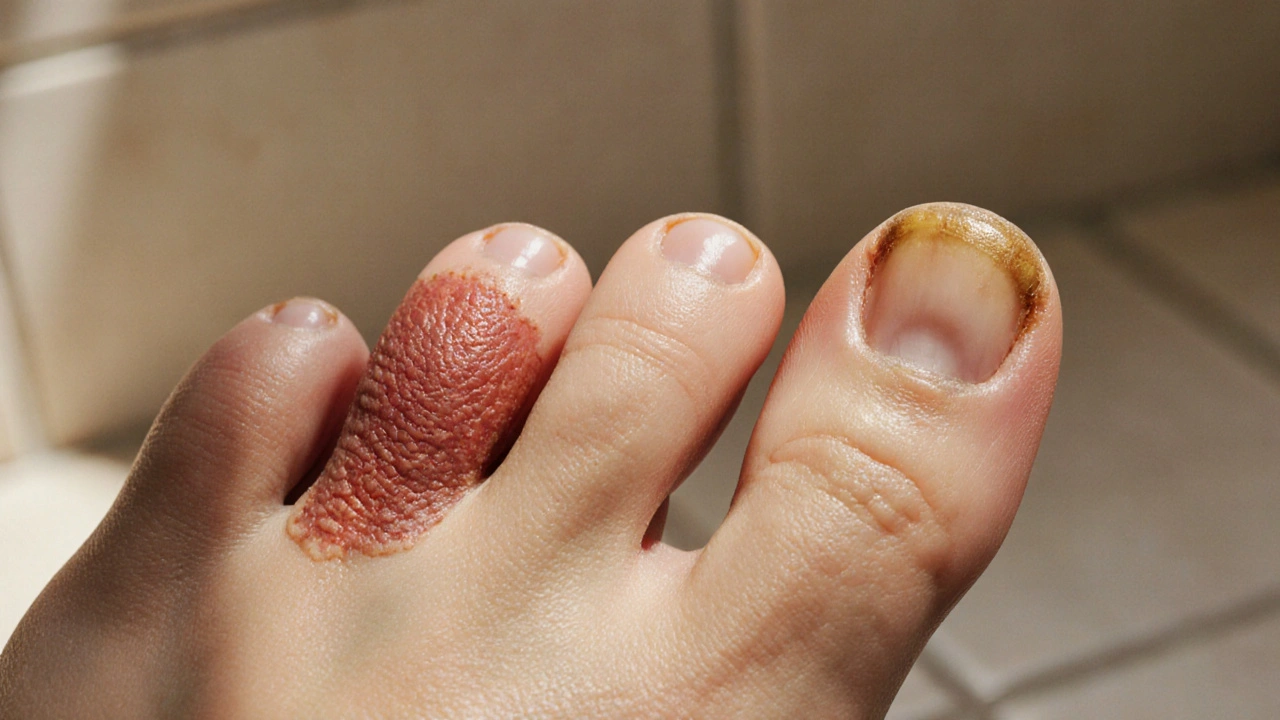Ringworm (Tinea Corporis): What You Need to Know
When dealing with Ringworm, a common fungal skin infection also called tinea corporis. Also known as tinea corporis, it spreads through direct contact or contaminated surfaces. Understanding ringworm means also looking at related concepts like Fungal infection, infections caused by dermatophyte fungi that thrive on keratin, Antifungal medication, drugs that stop fungal growth, available as creams, sprays or oral tablets and Skin hygiene, practices that keep the skin clean and dry to prevent fungal overgrowth. These entities interact: fungal infection creates the problem, antifungal medication provides the cure, and skin hygiene reduces the risk.
Ringworm appears as a red, scaly ring with a clearer center. The border often itches, especially after sweating or exercising. Dermatology guides note that the infection can affect any body part—arms, legs, torso, even the scalp. If you notice a circular rash that spreads outward, you’re likely seeing the classic ringworm pattern. The fungus thrives in warm, moist environments, which is why athletes, swimmers, and people who share towels are at higher risk.
How to Diagnose and Treat Ringworm Quickly
Diagnosis usually starts with a visual exam, but doctors may scrape a small skin sample for a lab test called a KOH prep. This confirms the presence of dermatophytes. Once confirmed, treatment options fall into two main groups: topical and oral antifungal medications. Over‑the‑counter creams like clotrimazole, terbinafine, or miconazole work well for small patches. For larger or more stubborn infections, prescription oral drugs such as terbinafine or itraconazole may be needed.
Besides medication, proper skin care speeds recovery. Gently washing the area with mild soap, patting it dry, and keeping it uncovered helps the medication penetrate. Applying a thin layer of antifungal cream twice daily for at least two weeks, even after symptoms fade, prevents recurrence. Some patients find that regular skin exfoliation reduces itching by removing dead cells that trap fungus, but be gentle—over‑scrubbing can damage the skin barrier.
Environmental control is another key piece. Wash clothing, bed linens, and towels in hot water (at least 60 °C) and dry them on high heat. If you share sports gear, disinfect it with a bleach‑based solution or antifungal spray. For pets, especially cats and dogs, veterinary advice is crucial because they can carry the same fungus and reinfect humans.
People with weakened immune systems—those on chemotherapy, steroids, or living with HIV—need extra caution. Their bodies may not fight off the fungus as effectively, so doctors often recommend a longer course of oral medication and closer monitoring. In such cases, a multidisciplinary approach involving dermatologists, infectious disease specialists, and primary care providers ensures the infection is fully cleared.
While ringworm is usually harmless, untreated cases can spread to other body parts or to other people. In rare instances, the infection can lead to secondary bacterial infections if the skin is constantly scratched. Prompt treatment keeps the infection contained and reduces the chance of complications.
Prevention strategies extend beyond personal hygiene. Public health guidelines suggest cleaning communal areas—locker rooms, gyms, swimming pools—regularly with antifungal cleaners. Schools and daycare centers should educate children about not sharing personal items and reporting any skin changes early. By fostering a culture of awareness, communities can cut down the overall incidence of ringworm.
For those looking for natural adjuncts, some studies show that tea tree oil, when used alongside conventional treatment, may have mild antifungal activity. However, it should never replace prescribed medication, especially for extensive infections. Always discuss any alternative remedies with a healthcare professional first.
In summary, ringworm is a straightforward fungal infection that responds well to timely treatment. Recognizing the characteristic ring, applying the right antifungal, and maintaining good skin hygiene are the three pillars of effective management. Below, you’ll find a curated list of articles that dive deeper into related topics—from skin exfoliation tips to the latest antifungal drugs and infection‑control best practices—giving you a broader view of how to keep your skin healthy and fungus‑free.

Ringworm vs Fungal Nail Infections: How They're Connected
Explore how ringworm and fungal nail infections are linked, their causes, spread, symptoms, and effective prevention and treatment options.




